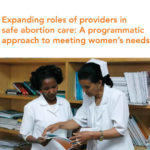Sex workers’ need for safe abortion services in Uganda is greater than that of the population of women of reproductive age because of their number of sexual contacts, the inconsistent use of contraception and their increased risk of forced sex, rape or other forms of physical and sexual violence. This study sought to understand sex workers’ experiences with induced abortion services or postabortion care (PAC) at an urban clinic in Uganda. Nine in-depth interviews were conducted with sex workers. Several important programmatic considerations for safe abortion services for sex workers were identified. Most important is creating community-level interventions in which women can speak openly about abortion, creating a support network among sex workers, training peer educators, and making available a community outreach educator and community outreach workshops on abortion.
Ipas author response to VSI’s letter to the editor,Osur et al.’s Implementation of misoprostol for postabortion care in Kenya and Uganda: A qualitative evaluation

This brief examines the key results from expanding abortion service provision to midlevel providers in 10 Ipas country programs throughout Asia and Africa, including a global analysis of programmatic data from all 10 countries and two case studies (Ethiopia and Bangladesh).

